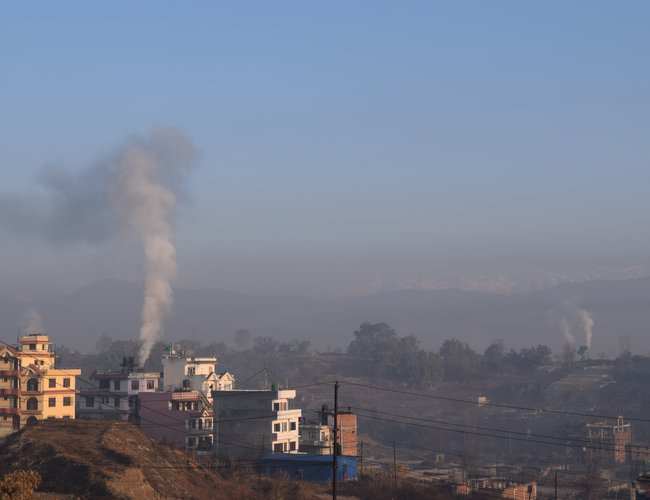
Frequent news on air pollution and its impact on human health in the Kathmandu Valley in the recent days called for recalling national concerns, willingness, commitments, and actions taken to reduce multiple source-based air pollution. Nepal's concerns on air pollution dates to over half-a-century. This note reminds us of our concerns, commitments, initiatives and self-experience about deteriorating air quality in the Kathmandu Valley as I spent over five decades for study and work in this city.
Nepal's National Report, prepared for the UN Conference on Human Environment, held at Stockholm, Sweden from 5 to 16 June 1972, documented that Kathmandu is experiencing "some pollution from exhaust smoke" and "is in the process of being solved by traffic facilities and regulations"; and "stricter traffic regulations are now being codified to control motorised traffic". Regarding pollution control from the cement factory, the report mentioned "the cement factory … has been required to attach an electrostatic precipitator unit at the additional cost of about Rs. 2.5 million to safeguard the surrounding air and land from pollution". It was the Himal Cement Factory which was established in 1967 in Chovar and shut down in 2002. In reality, it installed filters to arrest its dust emission, and pollution was one of the reasons for its shut down.
After two decades, Nepal shared another National Report, prepared for the UN Conference on Environment and Development, held at Rio de Janeiro in June 1992. The report informed the international community that "the emission from the increasing number of vehicles, brick kilns and cement factories result in a thick layer of smog over the Valley throughout the year except during the monsoon". It committed to develop a more comprehensive strategy on allowable standards on air, including other pollution, by covering major polluting sources.
After half-a-decade of the Rio Summit, Nepal published officially the State of the Environment (SoE) report on the occasion of the World Environment Day in June 1998 for the first time by using PSIR (pressure-state-impact-response) framework and it informed total suspended particulates and particulate matter (PM10) in Kathmandu exceed the WHO guidelines. It also mentioned increase in air pollution due to use of low octane, high content of lead and carbon in fossil fuels, and poor vehicle maintenance. The SoE reports were published in 2000, and sector SoEs in 2001 (Agriculture and Forestry), 2003 (Rural Energy) and 2004 (Eco-tourism) officially. In 2001, the then Ministry of Population and Environment (MoPE) joined UNEP and ICIMOD to publish a comprehensive SoE report of Nepal with support from NORAD. The draft SoE of 2008 linked impact of air pollution with economy and human health from particulate matter, increase in medical cost and lost productivity cost. The estimated health cost attributed to urban air pollution was over USD 21 million which was estimated to about 0.29 percent of the GDP of Nepal. The 2011 draft SoE considered rapid urbanisation, industrialisation and growing number of vehicles, and more demand for fossil fuel as key pressures to air pollution and stated Kathmandu Valley heavily polluted from particulates (TSP, PM10 and PM2.5), and linked to economy and human health. It reported over 4,700 people hospitalised annually due to air pollution, while emergency room visits were at around 93,400. The drafting of SoE reports continued annually till 2011 but they were not published officially from 2005 onwards.
Google search informs that "the Air Quality Life Index, 2023 report has found that air pollution has been shortening lives by 6.8 years in nine districts with the highest concentration of particulate pollution" (https://thehimalayantimes.com/environment/air-pollution-shortening-lives-by-68-years-report). This is self-explaining the decline in air quality and its impact on human health in the Valley.
National needs and international commitments and proven effects of air pollutants on human health along with policy and legal provisions, and institutional development stimulated Nepal to further engage in air quality improvement activities and introduce 'green sticker' to vehicles. The government issued Nepal Vehicle Mass Emission Standard (BS 2056) and revised Standard in BS 2069. The years 1999-2000 can be considered a 'golden year' to issue standards and stop registration of 'two-stroke engine' with a view to improve air quality under the leadership of Hon. Minister for Population and Environment, Mr. Bhakta Bahadur Balayar, popularly recalled as the 'tempo minister' who also led to stop movement of diesel operated three-wheelers and introduced 'microbuses' in the Valley. After nearly 4 years, the government issued National Ambient Air Quality Standard, 2060 (2003) which was revised and re-issued in 2012. Standards were issued chimney height of industries including emission standard and stack height for brick industry to reduce air pollution.
Prior to the establishment of the Department of Environment, air quality management plan was developed. The department assessed source-based air pollution and total emission load from various sources such as transport, industry, agriculture and domestic sources, reviewed relevant policies and laws, and prepared an integrated urban air quality framework, including strategies and action plan on ambient air quality management in the Kathmandu Valley in June 2017.
In 2019, the government launched three pillars (pollution control, sanitation and waste management, and greenery promotion) 'Nepal clean environment campaign' (mahaabhiyan) with an action plan. The plan includes number of activities along with promoting e-vehicle use, establishing charging stations, and enforcing Euro-4 or equivalent standard etc.
In 2020, the government approved the Kathmandu Valley Air Quality Management Action Plan (2076) with specific focus on pollution source-based actions to improve air quality in the Valley with a view to ensuring fundamental right to live in a clean and healthy environment. Several activities have been included in the action plan that range from the establishment of the emission test and fitness centers and compliance of emission standards to the establishment of charging stations for EVs, legal provisions to convert old vehicles to EVs, and implementation of mobile emission monitoring system.
This Action Plan provisions to constitute a multistakeholder Coordination Committee under the chair of the Minister for Forests and Environment for coordination and policy guidance to implement and review the actions and Action Plan Implementation Committee under the chair of the Secretary of the Ministry of Forests and Environment. Effective implementation of the Action Plan is expected to, inter alia, ensure: (i) fundamental right of the Nepali people to live in a clean and healthy environment; (ii) compliance to the National Air Quality Standard; (iii) decline in air pollution-induced diseases; and (iv) contribution to economic development and meet relevant Sustainable Development Goals. Pollution control, including air quality improvement in the Valley was a major concern when environment and pollution control activities were initiated in Nepal.
Two years back, the Department of Environment analysed the sources of pollution from 11 monitoring stations and confirmed never compliance with the standard for PM2.5 concentration. The annual report on Nepal's air quality status, published in 2022 by the department informs "PM2.5 is so minute that it can enter lungs and cause various respiratory-related diseases". It calls for taking urgent actions to control air pollution and protect human health. Several communicating channels have been used to inform people on air quality in the Valley. A newspaper on 14 January 2025 wrote air quality of the Valley 'very unhealthy'.
This reviewed "paper" commitment clearly indicates concerns of the government towards improving air quality of the Valley. There is no dearth of policy, legal provisions or actions which open multiple opportunities to tackle this threat and risk with multi-stakeholders' participation and support. What is lacking now is the implementation of the existing policies, legal provisions, standards, and agreed actions.
Nepal is widely known as a country with 'good paper policies and plans' and their weak implementation for the last five decades. Taking note of the state of air pollution and response measures without field level actions, local governments are encouraged to come forward and intervene sources of air pollution to the earliest possible and help people survive with their 'functional lungs'. Recalling air quality during the last 3 to 5 decades and its present state in the Valley, the government may wish to import handy 'oxygen-cylinders and/or respirators' to meet the needs of an increasing number of victims from air-pollution.

Batu Uprety
Former Joint-Secretary and Chief of Climate Change Management Division, Ministry of Environment (then), and former Team Leader, National Adaptation Plan (NAP) formulation process. E-mail: upretybk@gmail.com
- Teaming up Climate Change Negotiation
- Apr 18, 2025
- Sagarmatha Sambad: Likely Bearing the Fruits
- Mar 27, 2025
- Decadal Experience In Preparing The NDC
- Mar 03, 2025
- Damaging The Functional EIA Track
- Dec 22, 2024
- Baku CoP29 Outcomes And Nepal's Initiatives
- Nov 26, 2024














